Is Poland Spring Water from Poland Spring?
A consumer lawsuit accuses Pepsi of falsely promoting Poland Spring Water. The product is marketed as "100% Poland Spring water," but the plaintiff group of 11 say it's really ground water. The company is accused of false advertising and misleading customers, and the plaintiffs seek $50 million in damages.
According to the Food and Drug Administration (FDA), spring water has a specific definition: "Spring water shall be collected only at the spring or through a bore hole tapping the underground formation feeding the spring. There shall be a natural force causing the water to flow to the surface through a natural orifice." Although a Poland Spring did exist in Maine, according to the suit, it dried up almost 50 years ago.
The accusations are an issue of behavioral integrity, as my colleague Tony Simons defines it: doing what you say you will do. In other words, does Nestle Water promise something it doesn't deliver?
Nestle Waters denies the claims. In response to the suit, the company created an extensive web page with a brief statement, two videos, and an infographic. The statement reads as follows:
For more than 170 years, Poland Spring® has delivered great tasting spring water from Maine to millions of people in the Northeast. The claims made in the lawsuit are without merit and an obvious attempt to manipulate the legal system for personal gain. Poland Spring® is 100% spring water. It meets the U.S. Food and Drug Administration regulations defining spring water, all state regulations governing spring classification for standards of identity, as well as all federal and state regulations governing spring water collection, good manufacturing practices, product quality and labeling. We remain highly confident in our legal position.
They are taking a strong approach to counter the claims, and they accuse the plaintiffs of seeking personal gain. One of the videos, only 30 seconds, demonstrates principles of persuasion: emotional appeal, logical argument, and credibility.
Discussion:
What elements of persuasion (pathos, logos, ethos) do you find in the video example? What other communication strategies does Nestle Water use on its web page?
Analyze the full infographic from this page. What communication design principles does the infographic illustrate? How could it be improved?
Given what little we know so far about the case, what's your view? Do you side more with the plaintiffs or with Nestle Water?
Martin Shkreli's Failed Communications
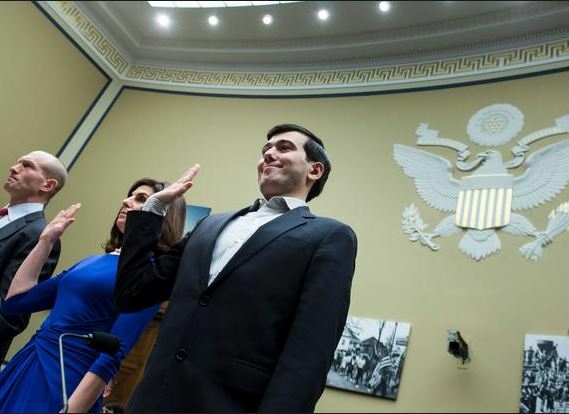 Former pharmaceutical executive Martin Shkreli damaged his own case by failing basic communication principles. As a juror said, he is "his own worst enemy" and "All he had to do was to tell everyone, ‘I'm sorry, I lost the money, all I can say is I'm sorry,' and that would be it."
Former pharmaceutical executive Martin Shkreli damaged his own case by failing basic communication principles. As a juror said, he is "his own worst enemy" and "All he had to do was to tell everyone, ‘I'm sorry, I lost the money, all I can say is I'm sorry,' and that would be it."
In other words, just apologize. The jury found him guilty of fraud because he lied to hedge fund investors.
Throughout his career in the media, Shkreli came across as arrogant and indifferent to his impact on others. His company hiked the price of Daraprim, a potentially life-saving drug, from $13.50 to $750 per pill. A Daily Beast article called him "reprehensible" and worse.
In 2014, he tweeted about his board of directors:
Rather upset at my inane BOD who was overly focused on irrelevant innuendo but also now can pursue a NewCo without them. So net-net excited.
In January of this year, Shkreli was banned from Twitter for harassing a journalist. In 2016, he testified before Congress, and we see why people consider him offensive. He "takes the fifth," which is his right, but his behavior shows his lack of compassion. MoneyWatch posted "The many smirks of Martin Shkreli" during the hearing.
Discussion:
- What is the value of an apology, and how could saying "I'm sorry" have helped Shkreli?
- What non-verbal behavior does Shkreli demonstrate? For example, watch 8:00 - 9:00 of the Congressional hearing. How do you interpret his non-verbals?
Gender Bias in Economics
 An economist's research has revealed gender bias among academics. A gutsy senior wrote her thesis at the University of California, Berkeley, based on online, informal conversations about the economics academic job market. By analyzing more than a million online comments, Alice Wu identified words associated with men and women.
An economist's research has revealed gender bias among academics. A gutsy senior wrote her thesis at the University of California, Berkeley, based on online, informal conversations about the economics academic job market. By analyzing more than a million online comments, Alice Wu identified words associated with men and women. 
Words associated with women (female pronouns) were far more sexual, while the words associated with men were more positive overall. The female list is jarring.
Wu took a big risk in doing this research and publishing her report. She was warned about facing online harassment, but she seems resolved to continue her work.
The organization hashtac compiled an extensive list of studies about gender bias in academe and conclude the following:
The studies aggregated and summarized below offer important policy implications for the traditional ways that we quantify the processes leading to hiring, promotion, and tenure. You cannot simply count "outputs" in making an evaluation of someone's worth and reputation if there is a "biased filter" at the first stage of evaluation, prejudicing judgment at the outset.
Discussion:
- What, if anything, surprises you about this research?
- How does this work relate to the concept of implicit bias discussed in Chapter 2 of the tenth edition of Business Communication?
- Wu certainly demonstrates courage. What is at risk for her personally and professionally?
- Despite several page views, I cannot find what the letters "hashtac" represent. Where on the website would be a good place for this?
Corona and Other Brands Capitalize on Eclipse
With the total eclipse coming Monday afternoon and glasses hard to come by, Corona is offering a solution. In a 35-second video, the company instructs us how to make a viewer from a beer box. 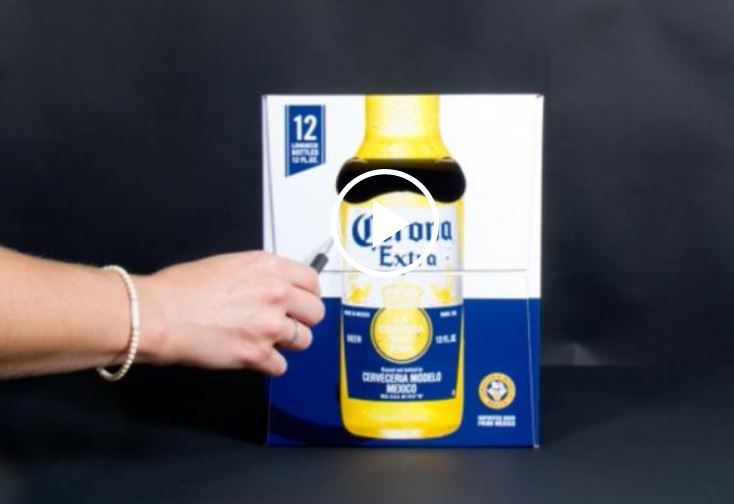 Apparently, solar corona is the beer's namesake, so the connection isn't entirely random. Ad agency Cramer-Krasselt created the campaign.
Apparently, solar corona is the beer's namesake, so the connection isn't entirely random. Ad agency Cramer-Krasselt created the campaign.
NASA Goddard posted a video to show how to make a viewer out of a cereal box, and a generic box is used as an example. But other companies have been using the eclipse to promote their brands.
A CNBC article identifies "17 clever ways brands are cashing in on the eclipse." Volvo, for example, designed a custom moon roof for viewing the eclipse from the road, but reports warn about traffic and accidents if people aren't careful while driving. Other companies are selling drinks, mattresses, train rides, houses, and a variety of food: half-moon cookies, donuts, pizza, and more.
Discussion:
- What are potential downsides of a brand associating with the eclipse and using the event to promote products?
- What is the most outrageous promotion you have seen related to the eclipse?
Brother's Response to My Complaint
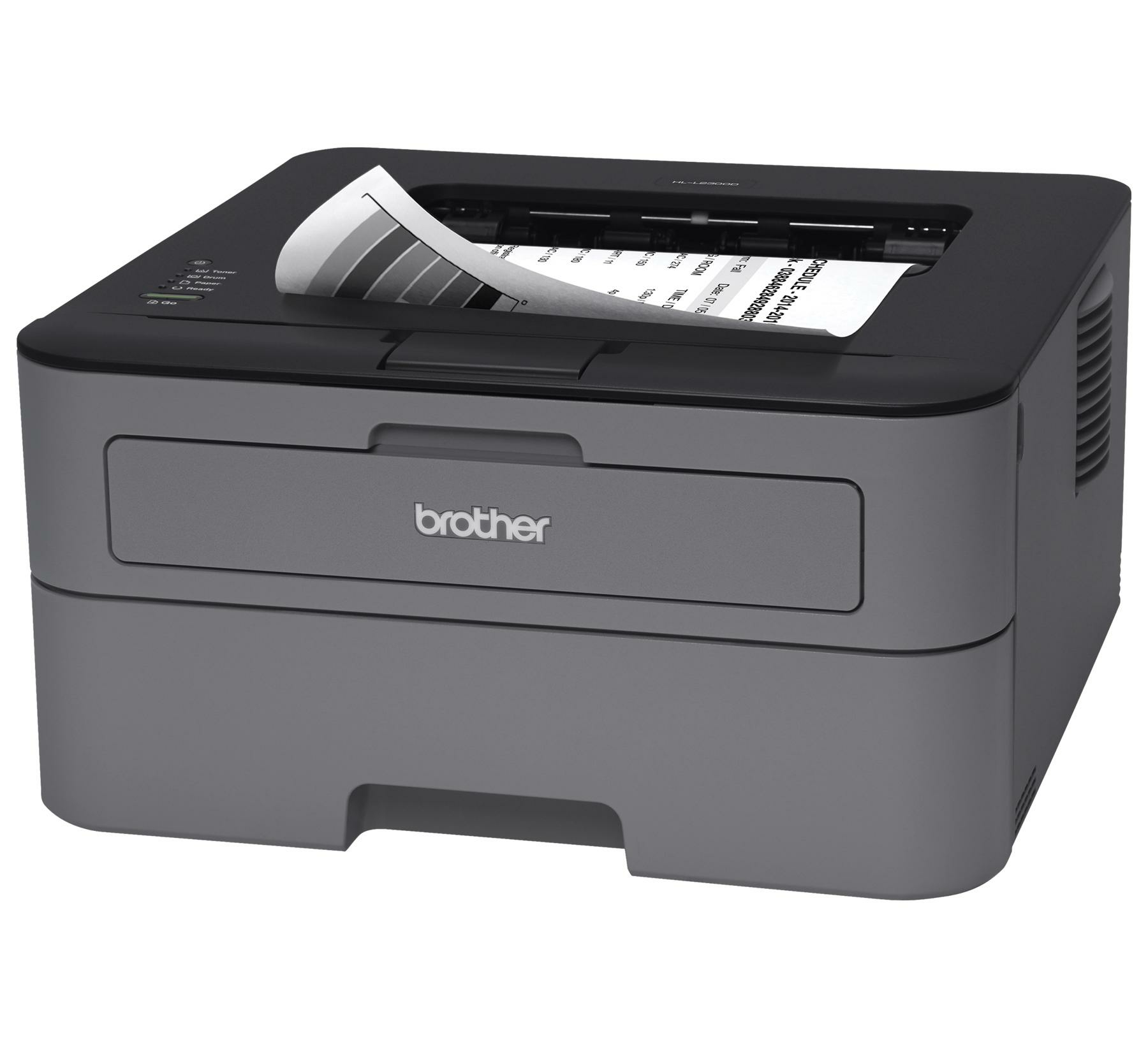 On my Brother printer, the "Toner Low" light came on, and I shook the toner, which always gives me several more pages of good quality printing. But at some point, the printer wouldn't print anymore. To my eye, the pages still looked good. I was printing pages of my new book to proofread and didn't notice a difference for my purpose.
On my Brother printer, the "Toner Low" light came on, and I shook the toner, which always gives me several more pages of good quality printing. But at some point, the printer wouldn't print anymore. To my eye, the pages still looked good. I was printing pages of my new book to proofread and didn't notice a difference for my purpose.
I emailed Brother to see if I could override the function and get more out of my cartridge. (Replacements cost about $50.) I saw several YouTube videos with instructions, so clearly I'm not the only one who has this idea. But I couldn't find my model. I asked Brother for help, and this is the response I received: download Brother printer response.
I appreciate that the purpose is up front in the email and that my question is answered. But the email is so long and not very well organized. Also, the writer spends a lot of time defending why the printers are set up to stop. Of course, quality is important, but shouldn't I get to decide what is "good enough" for my print jobs? My HP printers keep going until they're grey and streaked.
Discussion:
- What's your view of the function to stop printing? Am I just cheap, or should Brother avoid the shutoff?
- What are the communication objectives for Bother's response? What is important for a customer in this situation?
- How could the writer have organized the email differently?
- How clear are the instructions?
- What else would improve the message?
Email Persists
 A survey shows that CIOs (73%) and office workers (53%) agree that email will continue as the primary internal communication tool through at least 2020. When instant messaging became popular around 2004, analysts predicted it would outpace email, which obviously hasn't happened. Reports of email's demise were common until about 2010, when people may have realized how stubborn the technology is.
A survey shows that CIOs (73%) and office workers (53%) agree that email will continue as the primary internal communication tool through at least 2020. When instant messaging became popular around 2004, analysts predicted it would outpace email, which obviously hasn't happened. Reports of email's demise were common until about 2010, when people may have realized how stubborn the technology is.
Email's persistence isn't because it's a great tool. According to the MediaPost survey, CIOs did rate email best for daily communications (41%), but this is compared to other channels: in-person meetings (22%), instant messaging (13%), phone calls (9%), internal social networks (8%), and video conferencing (7%). I would argue that the channel depends on the purpose and audiences. Otherwise, this is a difficult question to answer.
The survey reporters criticized instant messaging because people expect an immediate response. But, again, this doesn't consider that IM has a different purpose and will often solve immediate problems. Academic research shows that people who use IM, perhaps paradoxically, feel they have more control over their work, possibly because they get work accomplished through IM instead of having to wait longer for an email response. Then again, in some circles, people are expected to respond to email immediately as well.
Discussion:
- What's your view of email compared to other communication tools, such as, instant messaging?
- What's the real value of email compared to other tools? Why do you think it has persisted?
- What's your biggest frustration with email?
- What, if any, tools, such as Slack, have you used to help manage email? What have you found helpful?
Comparing CEO Statements
 A writer for The New York Times doesn't condemn CEOs for leaving President Trump's business advisory councils, but she says that we should expect more, particularly from those who gave what she considers vague statements. Zoe Greenberg writes,
A writer for The New York Times doesn't condemn CEOs for leaving President Trump's business advisory councils, but she says that we should expect more, particularly from those who gave what she considers vague statements. Zoe Greenberg writes,
It's fine to thank these executives for doing the right thing. But to look to these men as brave leaders? Let's not lower our standards, both politically and morally, so far that we're cheering for the absolute bare minimum of human decency.
She gives the example of Brain Krzanich of Intel's statement:
I resigned to call attention to the serious harm our divided political climate is causing to critical issues, including the serious need to address the decline of American manufacturing.
The Los Angeles Times rounded up 15 CEOs' statements about their decision to leave, some before the Charlottesville incident. Comparing the statements and the reasons they identified is an interesting exercise. Some executives used the opportunity to promote their companies, and some gave more specific reasons that others.
Discussion:
- Which executives most used the opportunity to promote their company?
- Which gave the most vague and most specific reasons for leaving?
- What other differences do you notice?
- Which statements do you find most effective and why?
CEOs Leave President Trump's Business Advisory Councils
 Several CEOs have left or were planning to leave President Trump's business advisory councils after his response to the Charlottesville, VA, incident. President Trump has been stalwart in blaming "both sides" of the protests in Charlottesville, which escalated in violence. For some CEOs, the response wasn't strong enough in condemning white supremacists. In a news conference, President Trump said there was violence among the liberal contingent as well as those wanting to, for example, defend confederate statues. He drew an analogy between George Washington and Thomas Jefferson, who owned slaves, with Robert E. Lee, who led the confederate army during the U.S. civil war.
Several CEOs have left or were planning to leave President Trump's business advisory councils after his response to the Charlottesville, VA, incident. President Trump has been stalwart in blaming "both sides" of the protests in Charlottesville, which escalated in violence. For some CEOs, the response wasn't strong enough in condemning white supremacists. In a news conference, President Trump said there was violence among the liberal contingent as well as those wanting to, for example, defend confederate statues. He drew an analogy between George Washington and Thomas Jefferson, who owned slaves, with Robert E. Lee, who led the confederate army during the U.S. civil war.
Merck chief executive Ken Frazier was the first to resign from the president's manufacturing council. Others filed suit, and still others planned to resign, including Indra Nooyi of Pepsi, Jamie Dimon of JP Morgan, Alex Gorsky of J&J, and Jeff Immelt of GE.
Doug McMillon, Walmart's chief executive, has been vocal and has faced criticism from Walmart customers. In a memo to employees, McMillion explained his position:
As we watched the events and the response from President Trump over the weekend, we too felt that he missed a critical opportunity to help bring our country together by unequivocally rejecting the appalling actions of white supremacists. His remarks today were a step in the right direction and we need that clarity and consistency in the future.
Our country is facing some very difficult issues that require our elected officials, business leaders and community-based organizations to work together. Representing a company with the largest and one of the most diverse groups of associates in the U.S., and an even more diverse customer base of tens of millions of customers, we believe we should stay engaged to try to influence decisions in a positive way and help bring people together. I will continue to strongly advocate on behalf of our associates and customers, and urge our elected officials to do their part to promote a more just, tolerant and diverse society.
Thank you for representing Walmart and our values today -- and every day.
Before another group, inspired by Nooyi of Pepsi, could resign, President Trump decided to disband all of his business advisory councils. The decision is a blow to the president, who prided himself on his business relationships when taking office.
Discussion:
- Did these business leaders do the right thing? Why or why not?
- What did it take for Merck's CEO to take the lead, and for Pepsi's CEO to inspire the next wave? What was at risk for both of them and for other CEOs?
- Besides addressing the Charlottesville situation differently, what could President Trump have done differently to maintain his relationships with these business leaders?
Should We Curse at Work?
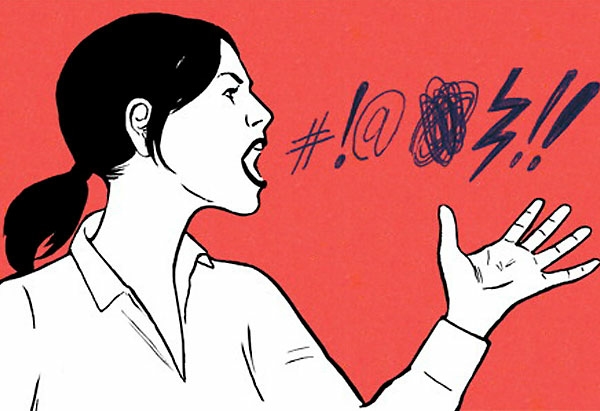 A book, What the F: What Swearing Reveals About Our Language, Our Brains, and Ourselves, explains why cursing is good for us. Author Benjamin K. Bergen also argues that cursing is a social construct: certain words are "bad" only because we say they are.
A book, What the F: What Swearing Reveals About Our Language, Our Brains, and Ourselves, explains why cursing is good for us. Author Benjamin K. Bergen also argues that cursing is a social construct: certain words are "bad" only because we say they are.
Cursing has some benefits. One study showed that swearing in response to an injury helps us tolerate pain. Another showed that swearing improved performance in bicycle and hand-grip exercises. Bergen argues that cursing allows people to show their emotional state instead of hiding it. He also says cursing brings people of similar backgrounds or cultures together.
But what about swearing at work? This seems to vary based on industry, company, and work group. Some cursing, such as ethnic slurs, are offensive and would rarely be tolerated. However, many teams will curse among themselves, depending on the relationships and circumstances.
Discussion:
- Do you curse? Why or why not? Under what circumstances would you curse or avoid it?
- How do you feel about cursing in professional work environments? What are the advantages and disadvantages?
Cargill Muslim Employees Get EEOC Support
 The Equal Employment Opportunity Commission (EEOC) is siding with Cargill employees over their right to pray at work. Employees filed a claim against the company because their opportunities to pray during breaks had been curtailed. The EEOC's support means that Cargill management will have to reach an agreement with employees on prayer time.
The Equal Employment Opportunity Commission (EEOC) is siding with Cargill employees over their right to pray at work. Employees filed a claim against the company because their opportunities to pray during breaks had been curtailed. The EEOC's support means that Cargill management will have to reach an agreement with employees on prayer time.
The issue began in Colorado in 2015 when 150 employees walked off the job in protest. Supervisors told them they would no longer be able to prayer during breaks. The employees were terminated for attendance violations.
Employees report being closely monitored so they didn't pray, for example, in the bathroom. Cargill denies such claims.
The hope is for Cargill and the employees to reach a confidential agreement. If they fail, the employees can pursue a discrimination lawsuit.
Discussion:
- What protects U.S. employees' right to pray at work?
- How would you describe the company's position?
- Assess statements by the company in the Star Tribune article. Based on these quotes, how well is the company responding to the controversy?
Many Perspectives on the Google Memo
 A Google software engineer's memo has further split conservatives and liberals in the workplace. The most divisive part of the 10-page, so-called "manifesto" seems to be the argument that biology partly explains why fewer women are in technology jobs. James Damore was fired following controversy about the memo.
A Google software engineer's memo has further split conservatives and liberals in the workplace. The most divisive part of the 10-page, so-called "manifesto" seems to be the argument that biology partly explains why fewer women are in technology jobs. James Damore was fired following controversy about the memo.
Here are a few highlights of the situation, particularly as they relate to communication:
The Engineer's Point of View
Damore argued in his memo that Google's diversity programs need to be reworked. Titled, "Google's Ideological Echo Chamber," the memo suggests Google de-moralize diversity, stop alienating conservatives, confront Google's biases, stop restricting programs and classes to certain genders or races, have an open and honest discussion about costs and benefits of diversity programs, focus on psychological safety instead of just race/gender diversity, de-emphasize empathy, prioritize intention, be open about the science of human nature, and reconsider making Unconscious Bias (Google's training program) mandatory for promotion committees.
His argument about empathy and claims that women are more neurotic than men seem to be perceived as most hurtful. Damore responded to his termination in a Wall Street Journal editorial.
A computer science lecturer at Stanford acknowledges that the memo cites some peer-reviewed studies. But she identifies fives reasons the memo is offensive to women in tech: fatigue (tired of hearing the arguments and feeling dismissed at work), resisting the divide-and-conquer strategy (women won't feel better if they aren't "average"), Google isn't average (yet Damore cites studies of averages), race is argued alongside gender (but Damore cites no research), and contradiction (he says he values diversity yet criticizes all of Google's programs).
In sum, women argue that technology is a challenging field filled with bias. The memo only hurts women's attempts to be valued and included in the workplace.
Google Leadership's Response
Google leadership had a right to terminate Damore. The question is whether this was the best decision. By posting his memo and given the subsequent conversations, Damore may have created a hostile working environment for Google. In an email to staff, CEO Sundar Pichai wrote, "portions of the memo violate our Code of Conduct and cross the line by advancing harmful gender stereotypes in our workplace." The VP of diversity, integrity, and governance-just two weeks on the job-wrote an email with her own perspective.
You can read more about Google's decision process here.
Conservatives' Point of View
Conservatives see this situation as emblematic of what Damore argues: that conservative voices are silenced. Damore called Google "cult-like" for its unwillingness to consider other points of view. Damore has filed suit against the termination. New York Times opinion writer David Brooks wrote that Pichai should resign for terminating Damore.
Discussion:
- From a perspective strictly of persuasion (or argumentation), what did Damore do well in his memo, and where did he fall short? What could he have done differently in this situation?
- To what extent do you agree with Damore's arguments? What are his strongest and weakest arguments?
- Did Google do the right thing in firing him? What are the arguments for and against his termination?
Line Chart Example
A New York Times article and corresponding charts show how income inequality has increased. In 1980, low- and middle-income people saw healthy increases in income growth. In 2014, those in the lower income percentiles saw the least growth, while the highest income earners saw the most growth.
The chart is different from a traditional line chart, which shows change over time. Each line, in this example, represents one year, and the X axis represents income level. It's effective because we see the dramatic difference between the two sample years, with a notable intersection around the 95th percentile and then a steep curve up for the very wealthy.
The Times, of course, tends to be a liberal paper, and the message is clearly anti-Trump's tax policies, but the chart illustrates the point well.
Additional charts show changes over time, and the Times calls this piece "interactive." The lines move, but "interactive" may be an overstatement.
Discussion:
- What main points do you take away from the chart?
- What's missing from the chart? How might Republicans who promote tax breaks for the wealthy argue with the representation?
- What other visuals could be useful to illustrate the points?
- How could you make the charts more interactive?
Irvine Finds Room for Admitted Students
 University of California, Irvine, is trying to do right by 800 students who accepted the college's admissions offer above the expected number. When making admissions decisions, colleges always consider their "yield," or the percentage of students who will enroll. Admissions officers admit more students than they have space for, assuming some won't come because of financial reasons or school preference.
University of California, Irvine, is trying to do right by 800 students who accepted the college's admissions offer above the expected number. When making admissions decisions, colleges always consider their "yield," or the percentage of students who will enroll. Admissions officers admit more students than they have space for, assuming some won't come because of financial reasons or school preference.
Initially, Irvine rescinded offers from about 500 students, but it was too late for them to enroll in other schools by that time. They informed students during the summer about transcript and other issues, which happens in a few cases each year, but this is an extraordinary number.
Then university administrators began softening. They admitted that they used standards that were too strict in order to lower their enrollment numbers. The vice chancellor wrote a message to students, including this excerpt:
We heard from some students that this year's process was too stringent and our customer-service approach needs improvement. I acknowledge that we took a harder line on the terms and conditions this year and we could have managed that process with greater care, sensitivity, and clarity about available options. Also contributing to the angst many of you have experienced is our traditional communication and outdated telephone systems that did not serve us well in this circumstance. For those who felt ignored or mistreated, I sincerely apologize.
We are making every effort to do better, immediately. I have directed the admissions team to step up the personal outreach to notified students. We're bringing in more people to review appeals and answer phones. We are committed to correcting any errors swiftly and providing the help you need in an empathetic and understanding way.
A few days later, Irvine's chancellor also apologized, and the university found a way to accommodate 290 more students. His message included this excerpt:
The stories of our students whose college dreams were crushed by our decision to withdraw admissions to hundreds of students are heartbreaking. And unacceptable.
This process is not working. We are a university recognized for advancing the American Dream, not impeding it. This situation is rocking us to our core because it is fundamentally misaligned with our values.
The apology is notable because we see so few of them from university presidents. Writers for The New York Times and Insider Higher Ed commented on the rarity of apologies, partly because of the complexity of academic institutions.
Discussion:
- Analyze the chancellor's and vice chancellor's messages. What communication principles do they use? How do the messages compare in content, tone, word choice, and organization?
- What should Irvine have done differently in this situation? What are all of the touch points with students that could have been improved?
Speculation About McCain's Body Language
 Desperate to know whether Senator John McCain would support President Trump's most recent healthcare plan, people took to Twitter to report signs. A Mashable writer jokes, "Journalists and regular viewers became McCain body language experts, watching the Republican Senator's every move, smile, blink, and nose scratch."
Desperate to know whether Senator John McCain would support President Trump's most recent healthcare plan, people took to Twitter to report signs. A Mashable writer jokes, "Journalists and regular viewers became McCain body language experts, watching the Republican Senator's every move, smile, blink, and nose scratch."
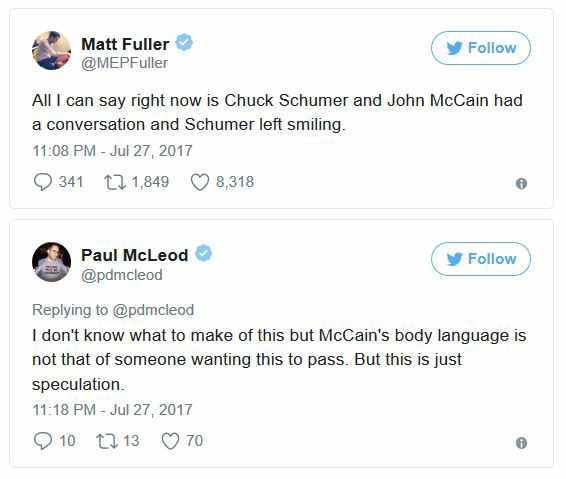 A Washington Post article cites evidence of a "no" vote: getting a hug from California Democrat Sen. Dianne Feinstein and observing two Republican senators apparently trying to persuade McCain to stick with their team.
A Washington Post article cites evidence of a "no" vote: getting a hug from California Democrat Sen. Dianne Feinstein and observing two Republican senators apparently trying to persuade McCain to stick with their team.
He did vote "no," along with two other Republicans who also broke ranks to defeat the plan. It's hard to see from the photo, but the Post reports, "Take a look at the body language in the room. Democrats look positively giddy (several audibly gasp, while others clap)." The writer also identifies, "Meanwhile, Sen. Mitch McConnell looks on with his arms crossed, resigned to defeat, as the rest of the GOP leadership team stands silently. Sen. Bill Cassidy (R-La.) lets his head drop."
Discussion:
- The speculation from body language turned out to be correct, but did people read too much into it?
- Should Senator McCain have been more discreet to keep his position private before the vote, or doesn't it matter? Consider McCain's history, if you know his background.
Communication Gaps Found Between Doctors and Home Health Care Nurses
 The findings aren't surprising for anyone who has cared for an elderly parent (as I have). Researchers at University of Colorado Anschutz Medical Campus identified major communication gaps when a patient is released from the hospital.
The findings aren't surprising for anyone who has cared for an elderly parent (as I have). Researchers at University of Colorado Anschutz Medical Campus identified major communication gaps when a patient is released from the hospital.
According to the study, published in Journal of General Internal Medicine, discrepancies in medication lists and a lack of accountability are key problems that cause issues for patients. Home health care agency workers also report difficulty in contacting physicians. Study authors identify the following solutions:
- Hospitals and primary care physicians could provide HHC agencies direct access to Electronic Medical Records and direct phone lines to doctors.
- Enact laws allowing nurse practitioners and physician's assistants to write HHC orders. A bill was under consideration to do this but was not acted upon by Congress.
- Clearly establishing accountability for hospital clinicians to manage HHC orders until a primary care physician can see a patient and help HHC nurses with questions.
- Create better communication methods with PCPs to ensure safer transitions
A page on the Family Caregiver Alliance website offers advice for patients when preparing for a medical appointment, meeting with a doctor, spending time in emergency rooms, and, as this study focuses on, "Transitions to Home or Facility: Communications at Discharge Time." The site offers good advice, such as keeping a medical notebook and contacting advocacy groups.
An article in the Journal of Clinical and Diagnostic Research recommends ways for doctors to improve their communication. The advice will sound very basic to students of business communication, for example, "patient listening, empathy, and paying attention."
Discussion:
- What are your positive and negative experiences when communicating with medical professionals? What improvements would you recommend?
- Communication gaps during transitions are common. What other examples can you identify (for example, transitioning from high school to college)?
BMW Denies Collusion
 German automakers felt another blow this weekend when they were accused of colluding. The news came as Daimler recalls 3 million cars, and Audi recalls 850,000 to lower their emissions.
German automakers felt another blow this weekend when they were accused of colluding. The news came as Daimler recalls 3 million cars, and Audi recalls 850,000 to lower their emissions.
German officials found documents related to a potential technology cartel when looking for evidence about potential anti-trust issues related to steel. To avoid penalties, VW and Daimler admitted meeting regularly with competitors. Spiegel magazine quoted VW as saying five German carmakers met "several times a year" and had been "co-ordinating the development of their vehicles, costs, suppliers, and markets for many years, at least since the Nineties, to the present day."
One area of discussion was about the size of the technology to hold AdBlue, a chemical cleaning substance. Automakers agreed on a smaller tank to reduce costs and allow more room for accessories, such as audio, but this meant less efficient cleaning of exhaust gases.
In a statement, BMW denied the accusations:
"BMW vehicles are not manipulated and comply with respective legal requirements," and "The BMW Group categorically rejects accusations that Euro 6 vehicles sold by the company do not provide adequate exhaust gas treatment due to AdBlue tanks that are too small."
VW may have learned a lesson from the emissions scandal. A New York Times article summarizes how earlier admissions may have helped avoided trouble:
If Volkswagen had been honest with American officials [in May 2014 when Winterkorn received a memo about the inconsistent test results], the damage to the company's reputation and finances would very likely have been serious but not devastating. Similar cases suggest that Volkswagen would have paid a fine in the hundreds of millions of dollars.
Discussion:
- Assess BMW's strategy. What principles of persuasion is the company using? What crisis communication techniques would be useful to the company at this point?
- To what, specifically, is VW admitting? What, specifically, is BMW denying?
- Where's the line between meeting and collusion?
Walmart Apologizes for Racist Description
 Walmart blamed a seller for a racist description of a hair weaving net. The blurb included the "N-word" as an adjective with "brown" for the product color.
Walmart blamed a seller for a racist description of a hair weaving net. The blurb included the "N-word" as an adjective with "brown" for the product color.
Walmart removed the description and issued an apology, shown here.
 The seller, Jagazi in the United Kingdom, said someone was using its name to sell products on Walmart's website. Jagazi wrote a statement denying connection with the product but didn't mention the racial slur.
The seller, Jagazi in the United Kingdom, said someone was using its name to sell products on Walmart's website. Jagazi wrote a statement denying connection with the product but didn't mention the racial slur.
We woke up this morning to the news that someone has used our name, Jagazi, to list an item. Please beware that we are reporting this to as many people as we can and trying to get all the listings pulled down. The real Jagazi is a 100% black company for black people. People have often used our brand name to try and sell their products. Please be aware. Very sorry for all the distress this has caused. We are feeling the pain here as well. Most shocking!
An AOL article author criticizes Jagazi for "indicating some offense to the racial slur and much offense to someone selling fake Jagazi on Walmart's website." Do you agree or disagree?
Discussion:
- How does a mistake like this happen?
- How well did Walmart handle the apology? Should the company take more responsibility? Why or why not?
- Assess Jagazi's response. What, if anything, should Jagazi have done differently?
- The AOL article has a punctuation error. Can you find it?
Did Ann Coulter Go Too Far?
 Have we had enough of customer complaints about airlines? The social media tenor seems to be trending in that direction, at least in the case of Ann Coulter and Delta Airlines.
Have we had enough of customer complaints about airlines? The social media tenor seems to be trending in that direction, at least in the case of Ann Coulter and Delta Airlines.
Author and media personality Ann Coulter paid $30 for a seat with more legroom but was "inadvertently" moved as the airline shuffled seats to accommodate other passengers. Coulter tweeted several attacks on the airline, including a couple about other passengers: the one at right and, in another tweet, "Immigrants take American jobs (& seats on @Delta)." 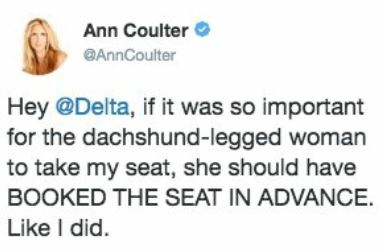
Delta promised to refund Coulter's $30 and pushed back on her insults. In tweets and in a statement, the company admitted confusion:
We are sorry that the customer did not receive the seat she reserved and paid for. More importantly, we are disappointed that the customer has chosen to publicly attack our employees and other customers by posting derogatory and slanderous comments and photos in social media. Her actions are unnecessary and unacceptable.
Each of our employees is charged with treating each other as well as our customers with dignity and respect. And we hold each other accountable when that does not happen.
Delta expects mutual civility throughout the entire travel experience.
We will refund Ms. Coulter's $30 for the preferred seat on the exit row that she purchased.
Brandwatch assessed sentiment on social media and found more negative responses to Coulter than to Delta.
Discussion:
- Do you find yourself sympathizing more with the airline or with Coulter? Why?
- How does the timing (moving her seat within 24 hours of the flight) affect your response, if at all?
- Where did Coulter perhaps cross a line? Read more tweets here.
- How well did Delta handle the situation? What, if anything, should the airline have done differently on social media or in the statement?
What Happens When a 15-Year-Old Manages the Twitter Account?
 For Southern Rail in the U.K., an intern taking over the Twitter feed was a welcome reprieve from angry customer tweets. Eddie, the 15-year-old intern put out a call for people to ask him anything. And they did.
For Southern Rail in the U.K., an intern taking over the Twitter feed was a welcome reprieve from angry customer tweets. Eddie, the 15-year-old intern put out a call for people to ask him anything. And they did.
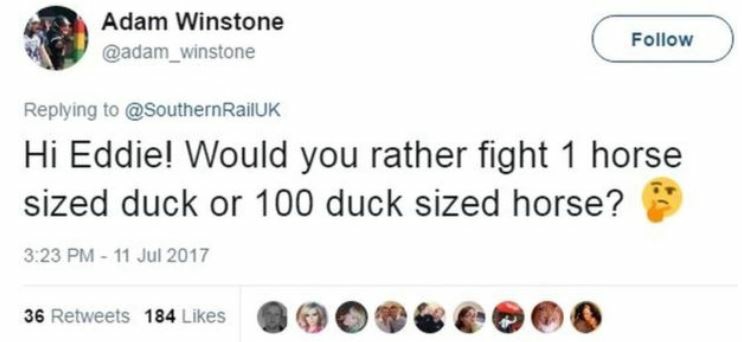
 Eddie answered each. The answers to the questions at right were 100 duck-sized horses and rollerblades for feet. (Note that he corrected the grammar and punctuation for the first one.)
Eddie answered each. The answers to the questions at right were 100 duck-sized horses and rollerblades for feet. (Note that he corrected the grammar and punctuation for the first one.)
A few users got snarky. About the rollerblade response, one wrote, "And you'd get there faster than on a @SouthernRailUK service too." Another tweeted, "Nobody wishes to troll a 15 year old [sic], but Eddie should be made well aware how lives are being ruined by GTR." To this, a regular member of the train company's Twitter team responded, "We're showing a 15 year old the wonderful world of work today. Appreciate if you could lay off the abuse for a bit."
Discussion:
- The organization could have shut down the questions or left responses to the regular employees. Did they do the right thing? Why or why not?
- How is this situation different from and similar to other hijacked hashtags?
- As far as I see, the tweets are fun but not mocking. What do you see as the difference? If they were more mocking, how should Southern Rail have responded?
- In the book, we talk about an authentic social media voice. How do Eddie's tweets measure up?
WSJ Article Encourages Exotic Clothes for Networking
 Time to go shopping. A Wall Street Journal article profiles Pradeep Aradhya, a digital marketing executive and investor, about his approach to networking. He says that networking didn't come easy to him, but he now attends events for six to eight hours a week and finds ways to stand out.
Time to go shopping. A Wall Street Journal article profiles Pradeep Aradhya, a digital marketing executive and investor, about his approach to networking. He says that networking didn't come easy to him, but he now attends events for six to eight hours a week and finds ways to stand out.
Aradhya follows a model he learned to "entertain, enlighten or enrich" others. He also changed his wardrobe from traditional suits to "crushed silk or woven with metallic thread, and wears exotic-looking designer shoes." According to Aradhya, he doesn't always have to start conversations; often, people will comment on his unusual clothing. Another strategy is saying something shocking, such as introducing himself as the king of India.
An article in Career Ladders offers advice for networking attire. The recommendations sound prescriptive-based on the event, for example, a barbecue or a cocktail party. For women going to a cocktail party, for example, the article suggests the following:
Choose a cocktail dress that is flattering and exposes a tasteful amount of skin. No plunging necklines or bandage dresses, please. Look for a hem that grazes the knee - any longer, and you will look dated; any shorter, and you will look like you belong in a club. Dresses made in chiffon or silk lay nicer than satin, which tends to rumple in all the wrong places. A silhouette that flatters almost any women's body is sleeveless, with a scoop neck, fitted waist and slightly fuller skirt. Avoid fussy prints and stick to colors that translate well at night: black, gray, shades of red and navy. Wear open-toed heels and your favorite ear or neck sparklers for a finishing touch.
Compared to Aradhya's strategy, this is certainly a conservative approach.
Discussion:
- How do you balance presenting your "best self" and being authentic? Can you think of times when you felt inauthentic during a networking or another type of event? What were the circumstances, and what did you learn?
- How do you know what risks to take during networking? What's enough to distinguish you, and what's too much?
- How important do you think attire is during networking events? How difficult is it to overlook someone who isn't dressed for the part but may be a great business partner or hire?
























